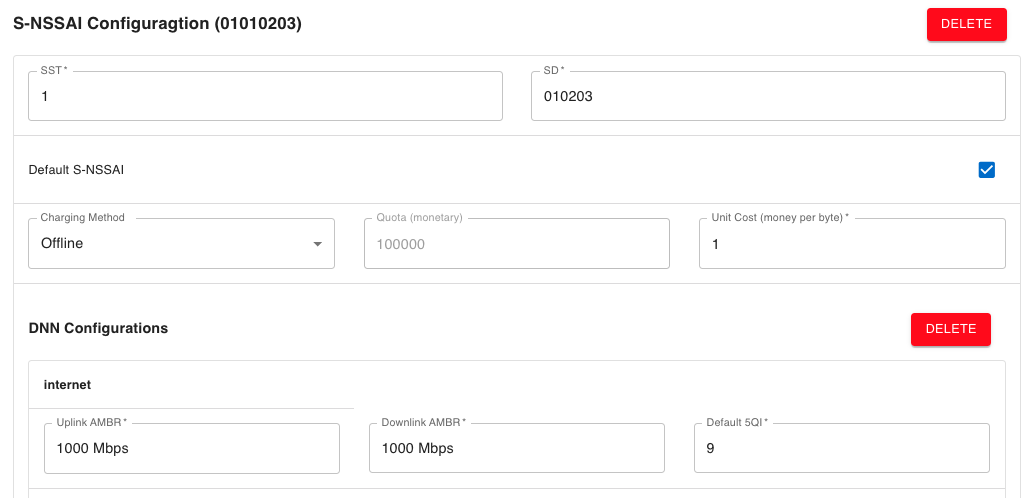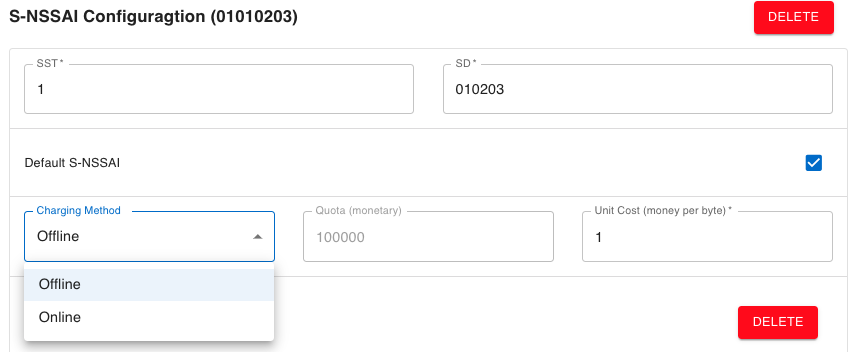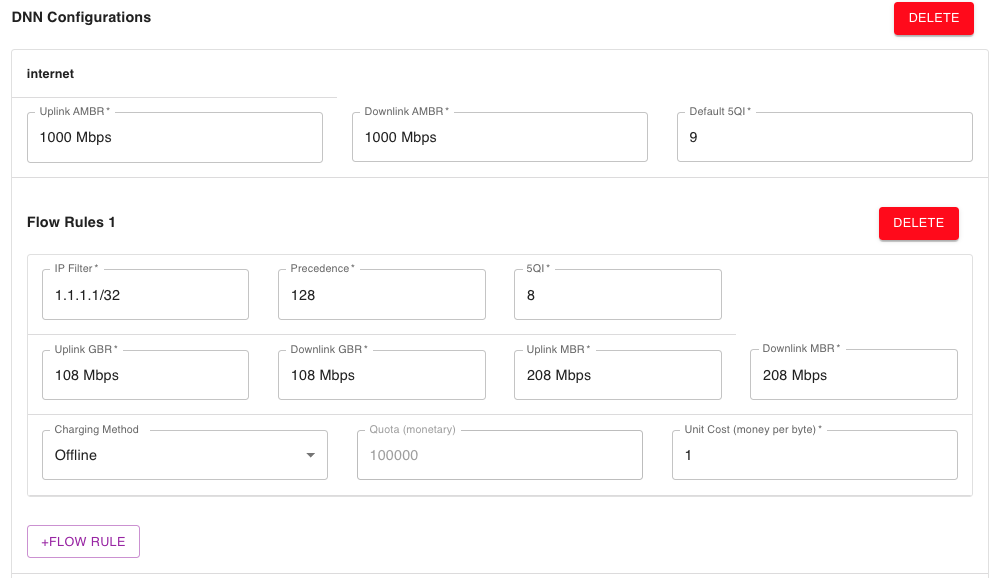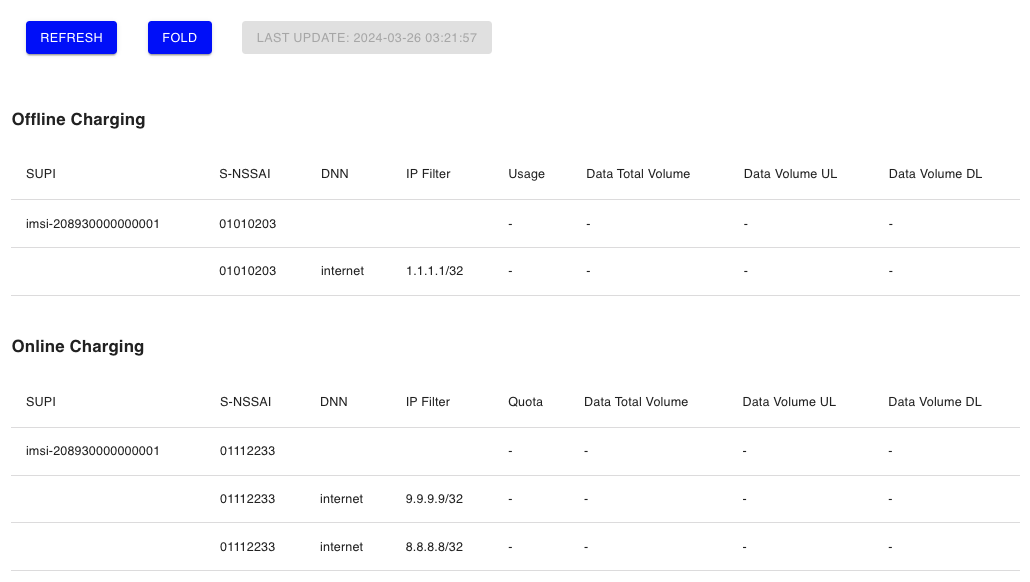Setup Charing for UE
In this demo, we will practice:
- Set Slice-level and Flow-level Offline charging in webconsole.
- Set Slice-level and Flow-level Offline charging in webconsole.
- Test with UERANSIM
Notice:
The charging function was released in free5GC v3.4.1.
0. Preface
- free5GC provides Converge Charging, which includes Online and Offline.
- Support Slice-level and Flow-level Charging.
- Offline
- After network resource usage, charging information is transmitted from the network to the Billing Domain (BD).
- Online
- Before network resource usage, the network sends an authentication request to the Online Charging System (OCS) and gets quota.
1. Create Subscriber
-
The basic setting for subscribers will be ignored in this article; you can refer to this if you needed.
-
The default would create two slices, 01010203 and 01112233.
01010203

-
We could change the charging Method from Offline to Online if you needed.

-
We keep using Offline for now.
-
By default, there would be one flow rule to 1.1.1.1/32.

-
Remember to use the same Charing Method as slice-level charing.
-
For now, we will keep it Offline.
01112233

-
We use Online Charging for this slice.
-
Create flow rules.
- Remember to use the same charging method as Slice-level.

-
-
Click Create.
2. Check Charging Data in Webconsole
-
Click UE CHARGING in webconsole sidebar

-
We would see the Charging Data we set in Step 1.
- Expand

- Fold

3. Test with UERANSIM
-
Refer to this to set up your environment.
-
Provide
free5gc-ue.yamlI use for your reference.# IMSI number of the UE. IMSI = [MCC|MNC|MSISDN] (In total 15 digits) supi: 'imsi-208930000000001' # Mobile Country Code value of HPLMN mcc: '208' # Mobile Network Code value of HPLMN (2 or 3 digits) mnc: '93' # SUCI Protection Scheme : 0 for Null-scheme, 1 for Profile A and 2 for Profile B protectionScheme: 0 # Home Network Public Key for protecting with SUCI Profile A homeNetworkPublicKey: '5a8d38864820197c3394b92613b20b91633cbd897119273bf8e4a6f4eec0a650' # Home Network Public Key ID for protecting with SUCI Profile A homeNetworkPublicKeyId: 1 # Routing Indicator routingIndicator: '0000' # Permanent subscription key key: '8baf473f2f8fd09487cccbd7097c6862' # Operator code (OP or OPC) of the UE op: '8e27b6af0e692e750f32667a3b14605d' # This value specifies the OP type and it can be either 'OP' or 'OPC' opType: 'OPC' # Authentication Management Field (AMF) value amf: '8000' # IMEI number of the device. It is used if no SUPI is provided imei: '356938035643803' # IMEISV number of the device. It is used if no SUPI and IMEI is provided imeiSv: '4370816125816151' # List of gNB IP addresses for Radio Link Simulation gnbSearchList: - 127.0.0.1 # UAC Access Identities Configuration uacAic: mps: false mcs: false # UAC Access Control Class uacAcc: normalClass: 0 class11: false class12: false class13: false class14: false class15: false # Initial PDU sessions to be established sessions: - type: 'IPv4' apn: 'internet' slice: sst: 0x01 sd: 0x010203 - type: 'IPv4' apn: 'internet' slice: sst: 0x01 sd: 0x112233 # Configured NSSAI for this UE by HPLMN configured-nssai: - sst: 0x01 sd: 0x010203 - sst: 0x01 sd: 0x112233 # Default Configured NSSAI for this UE default-nssai: - sst: 1 sd: 1 # Supported integrity algorithms by this UE integrity: IA1: true IA2: true IA3: true # Supported encryption algorithms by this UE ciphering: EA0: true EA1: true EA2: true EA3: true # Integrity protection maximum data rate for user plane integrityMaxRate: uplink: 'full' downlink: 'full' -
If you set it up successfully, you will see the UERANSIM create two tunnels,
uesimtun0, anduesimtun1. -
The following is a Demo GIF for Charing

-
Result

-
You can try it out for the Charing Functionality now!